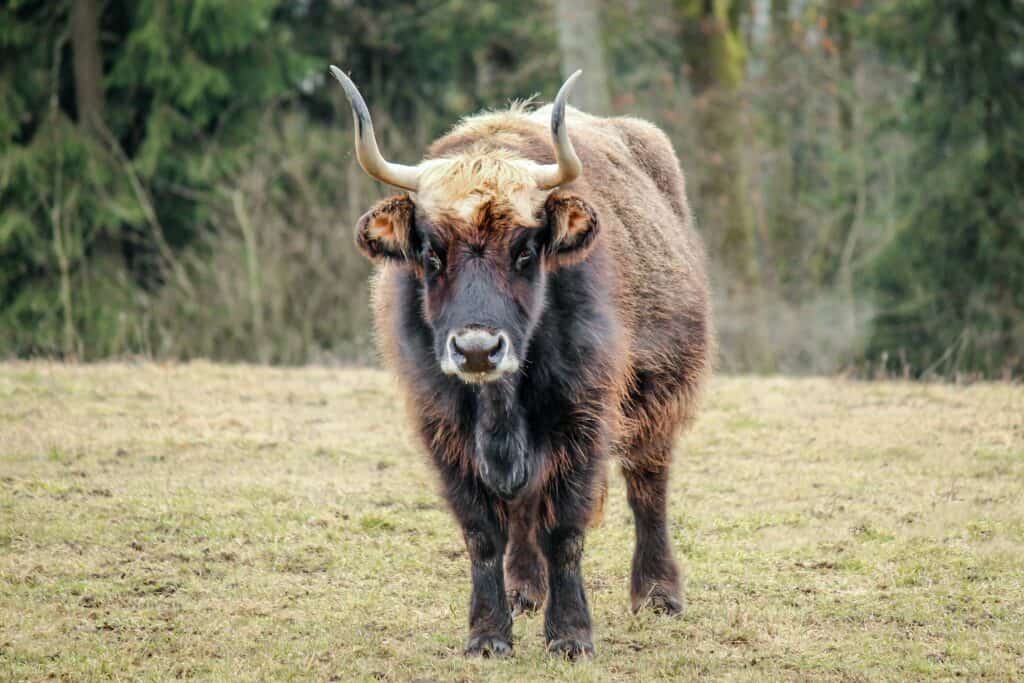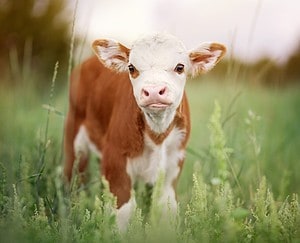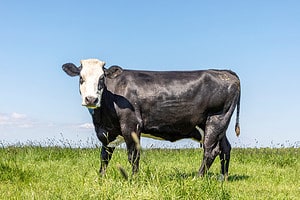Cattle are massive, domesticated animals with cloven hooves. They are the most common of the Bos species and a notable representative of the subfamily Bovinae. Heifers are female mature cattle, while bulls are male adult cattle. Milk-producing heifers are cows.
More than 250 distinct breeds have been identified across the globe, with more than 80 widely available to US farmers. Meat and milk production make cattle an essential domestic animal. So, what is the cattle and cow population of the world? Let’s find out!
How Many Cattle and Cows Are Left in the World?

Wagyu cows are some of the most prized cattle in the modern day. These cattle produce high-quality meat with unique, intensive marbling and distinct flavors.
©Filmbildfabrik/Shutterstock.com
About 1.5 billion cattle graze the planet. About 75 percent of this total is made up of cows or female cattle. This is because cows are in higher demand. Also, a single mature bull can mate with up to 50 cows!
India, Brazil, and the United States are home to the world’s three largest cattle and cow populations. There is approximately one cow for every five humans. In 2009, cattle were one of the first domesticated animals to have their entire genome mapped. New Zealand has more cattle than humans.
Is The Cattle and Cow Population Endangered?
Many farmers have felt economic pressure to switch to industrial cow breeds. As a result, many traditional breeds of the cattle and cow population have gone extinct in recent years. As a result, wealthy countries face an especially grave threat to their genetic resources of cattle, sheep, and goats.
The Pineywoods cow, one of the oldest in the United States, does very well in the South. Spanish cattle imported to the Americas in the 16th century are the ancestors of today’s breed. Pineywoods cattle were once used to produce both timber and beef; they thrive in the hot climates of Alabama, Mississippi, and Georgia. They are heat-tolerant, low-forage-eating cow that is resistant to parasites. However, the global population of Pineywood cattle is less than 5,000, making them critically endangered.
How Are Cattle and Cow Beneficial to Our Ecosystem?

Cattle protect wildlife habitats, prevent soil erosion, boost biodiversity, suppress wildfires, and create natural fertilizer.
©Canetti/Shutterstock.com
Cattle are essential to the ecosystem because they help prevent soil erosion, increase biodiversity, safeguard wildlife habitats, slow the development of wildfires, and produce natural fertilizer. Also, land that is unusable for people is put to good use by cattle. Cattle collect and consume plants where they grow. About 85 percent of the nutrients that cattle consume are returned to the grass. The plants and the entire ecosystem gain from this since it kickstarts the cycle of nutrients.
Beef, milk, and leather are the three most popular reasons for keeping cattle as livestock. The potential uses for cattle that have been crossbred are virtually limitless. Both humans and machines benefit from their services (oxen or bullocks, which pull carts, plows, and other implements). Cattle feces can be used for either fertilizer or as an energy source. Cattle and cow populations are also considered sacred in certain parts of the world, including India.
How Are Cattle and Cow Harmful to Our Ecosystem?
There are worldwide problems caused by cattle that need fixing, too. Cattle, for instance, produce more greenhouse gases than any other species of livestock, accounting for about 10% of global emissions. Methane gas emissions from a single cow range from 154 to 264 pounds annually.
Greenhouse gases are a major threat to human and environmental health. They contribute to global warming by retaining heat, which has consequences for many animals in dry regions. Extreme weather, wildfires, droughts, and interruptions in food supply are all exacerbated by climate change brought on by human-caused greenhouse gas emissions.
Are There Any Cattle That Are Extinct?

Though
aurochs
are extinct, European cow breeds retain their DNA.
©Annabell Gsoedl/Shutterstock.com
The aurochs, also known as Bos primigenius, is an extinct species of the cattle and cow population that is generally acknowledged as the wild father of the domesticated cattle species. Unfortunately, widespread hunting had driven this magnificent creature to oblivion by 1627. Even though aurochs are extinct, not all is hopeless. The old cattle breeds that still exist across Europe today have remnants of their DNA. Ancient Egyptian reliefs, Greek and Roman sculptures, and even Bronze Age figurines all feature aurochs.
Abruzzese cattle, Alderney cattle, Camblel Island cattle, Fribourgeoise, and Niata cattle are also among the extinct species of cattle.
What Would Happen If Cattle and Cows Went Extinct?
The U.S. beef market is valued at $88 billion (USDA). There would likely be substantial economic repercussions if cattle went extinct. Millions of people around the world rely on the income, livelihood, and security that cows provide. If cows disappeared from the planet, these resources would disappear with them.
The photo featured at the top of this post is © Clara Bastian/Shutterstock.com
Thank you for reading! Have some feedback for us? Contact the AZ Animals editorial team.







